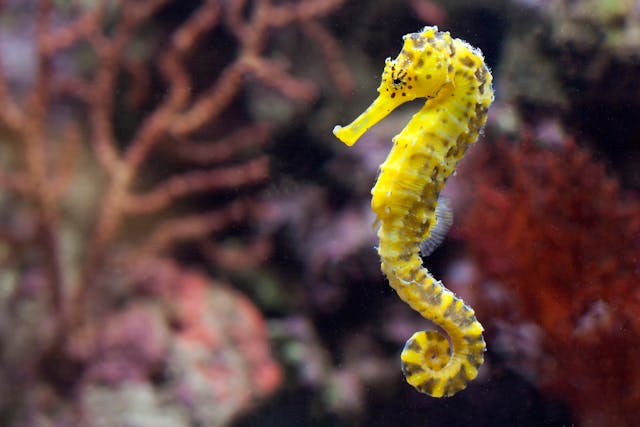
Why do male seahorses give birth? Male seahorses give birth because it gives the female time to make more eggs.
All living organisms have to reproduce in order to keep their DNA going. However, they don’t all reproduce in the same way. There are two types of reproduction: sexual and asexual. There is only one way for sexual reproduction to happen, but there are four ways that asexual reproduction can occur. A species can reproduce by binary fission, which is where a cell, such as a bacterium, doubles its DNA and then splits into two cells, each with a copy of the DNA. There is budding, where a small bud grows on the parent’s stem, with the exact same DNA, and then breaks off and becomes a separate plant. There is fragmentation, where a piece of the parent breaks off and becomes a new individual. And there is parthenogenesis, where an embryo develops from an unfertilized cell. In sexual reproduction, a male and a female are required. Each parent produces a cell that has half of that parent’s DNA. The cells combine, and create a new organism. In almost all species that reproduce with sexual reproduction, the cells combine in the female.
Both of these systems have advantages and disadvantages. Sexual reproduction produces more variation because two different DNAs are being combined. Asexual reproduction copies the same DNA, so genetic mutations will be copied as well. A single disease could wipe out a population more easily. However, sexual reproduction requires more time, and more energy. Asexual reproduction is fast and easy.
So, why do we have male and female? There are some species that are hermaphrodites, which means they are both male and female. In the beginning, organisms probably reproduced asexually. Sexual reproduction evolved about 2 billion years ago, and most organisms that used it were probably hermaphrodites. They produced the male sex cell, but they also had the female sex cell, so they could both give and receive the sex cell. Over time, many of them evolved to only have the male sex cell because it was easier and required less energy. Once there were a lot of organisms that were only male, the remaining hermaphrodites evolved to be only female because their male parts were out competed by the organisms that were only male. They could save energy by only being female. That is why most organisms that reproduce sexually have males and females and in almost all cases, the female receives the male sex cell and gestates it.
A family of fish called Syngnathidae, that include sea horses, are the only exception here. The female sea horse has the female sex cell, the egg, with her half of the DNA. The male sea horse has the male sex cell, the sperm, with his half of the DNA. However, unlike with most organisms, the female transfers the egg into the male, where he fertilizes it. The male seahorse has a pouch on the front of his tail, where the female inserts the egg. He fertilizes it with his sperm and the eggs start to gestate. The pouch is connected to the seahorses circulation with small placenta like structures and he can supply the growing babies with all the oxygen and nutrients that they require. The babies grow larger inside the male seahorse for 24 days.
When the babies are grown, the male seahorse gives birth to them, but in a different way to female birth. In females, a hormone called oxytocin rises and causes the smooth muscles of the uterus to contract and push the baby out. This is an involuntary muscle movement and it happens without conscious decision. The male seahorses don’t have this hormone and they don’t have the involuntary smooth muscles. What they do have is skeletal muscle that connects to the pouch at the bottom. When the male is ready to give birth, he uses these muscles to contract the pouch and squirt the babies out into the sea. These skeletal muscles have to be moved consciously, as when you go to pick up a cup of coffee, but experts don’t know how the seahorse knows when to give birth. There is the possibility that something overrides the conscious muscles and makes the move subconsciously. A seahorse can give birth to about 2,000 babies at once.
So, why does the male give birth rather than the female? The theory is that each time the male gives birth to a couple of thousand tiny seahorses, but a huge number of them are eaten by predators. If the female gave birth, she would have to wait for that 24 days or so to pass before she could start making a new egg and the species wouldn’t survive. If the male gives birth, the female has time to produce a new egg and they can give birth almost constantly. And this is what I learned today.
Photo by Jeffry Surianto: https://www.pexels.com/photo/close-up-of-seahorse-8887695/
Sources
https://animals.howstuffworks.com/fish/male-seahorses-give-birth.htm
https://en.wikipedia.org/wiki/Syngnathidae
https://oceanservice.noaa.gov/facts/seahorse.html
https://en.wikipedia.org/wiki/Evolution_of_sexual_reproduction
